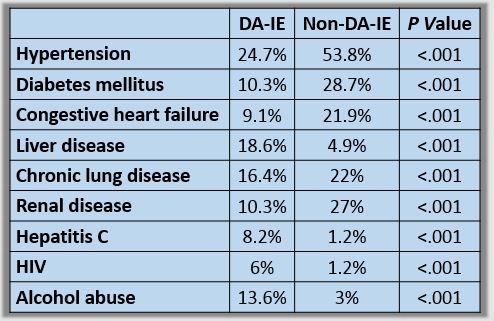Alarming Increase in Heart Infections Linked to Opioid Epidemic
Cases of infective endocarditis are on the rise and a new study suggests the opioid epidemic could be to blame.
Please click image to enlarge (Adapted from Harb SC. J AM Heart Assoc. 2019;8:e012969)

Incidence of drug abuse (DA)-related heart infections has nearly doubled in the US, according to a new study.
The study, published September 18 in the Journal of the American Heart Association, found that infective endocarditis (IE) has been growing at an alarming rate across the US – largely due to the opioid epidemic – and predominately impacts young, white men.
IE – a life-threatening infection in either the heart’s inner lining or valves – has been increasing over the past 20 years with nearly 34 000 patients being treated each year and DA is a major risk factor.
“Infective endocarditis related to drug abuse is a nationwide epidemic. These patients are among the most vulnerable – young and poor, and also frequently have HIV, hepatitis C and alcohol abuse,” senior author Serge C. Harb, MD, assistant professor of medicine at Cleveland Clinic Lerner College of Medicine, Ohio, told the American Heart Association in an interview.
In the retrospective cohort study, Harb and colleagues analyzed data on approximately 1 million hospitalized patients with IE (51% male, 72% white, median age of 68 years) from the National Inpatient Sample registry.
Between 2002 and 2016, the prevalence ratio of DA-related IE (DA-IE) nearly doubled in the US from 8% to 16%. DA-IE increased across all US regions as well, with the Midwest region having the highest prevalence ratio (4.9%).
After comparing patients with DA-IE to those with non-DA-IE, they were found to be:
- Young, white men (median age of 38 years vs 70 years, respectively)
- On Medicaid (~45%)
- In the lowest quartile of median household income (~42%)
NEXT: Results & Study Conclusions
Patients with DA-IE were less likely to have hypertension, diabetes, congestive heart failure, renal disease, or chronic lung disease vs those with non-DA-IE. More patients with DA-IE, however, had hepatitis C, HIV, liver disease, and alcohol abuse (see image on right).
Researchers also found that patients with DA-IE had longer hospital stays and had higher health care costs vs those with non-DA-IE. The DA-IE cohort underwent cardiac or valve surgery more often, but they had lower inpatient mortality (6.4%) vs the non-DA-IE cohort (9.1%).
This study was the first to report population-level trends of DA-IE geographically across the US, however, “further research is needed . . . to identify clusters or ‘hot zones’ of DA-IE outbreaks, such as in rural areas where opioids are more likely to be abused,” researchers noted.
Patients with DA-IE are complex and further resources and specialized teams are needed to not only treat their heart infection, but their addiction as well.
“Specialized teams, including . . . cardiologists, infectious disease specialists, cardiac surgeons, nurses, addiction specialists, case managers and social workers, are needed to care for these patients,” Harb said in the same American Heart Association interview. “Appropriately treating the cardiovascular infection is only one part of the management plan. Helping these patients address their addictive behaviors with social supports and effective rehabilitation programs is central to improving their health and preventing drug abuse relapses.”
Stay in touch with Patient Care® Online:
- Subscribe to our Newsletter
- Like us on Facebook
- Follow us on Twitter
- Write or Blog for Patient Care® Online